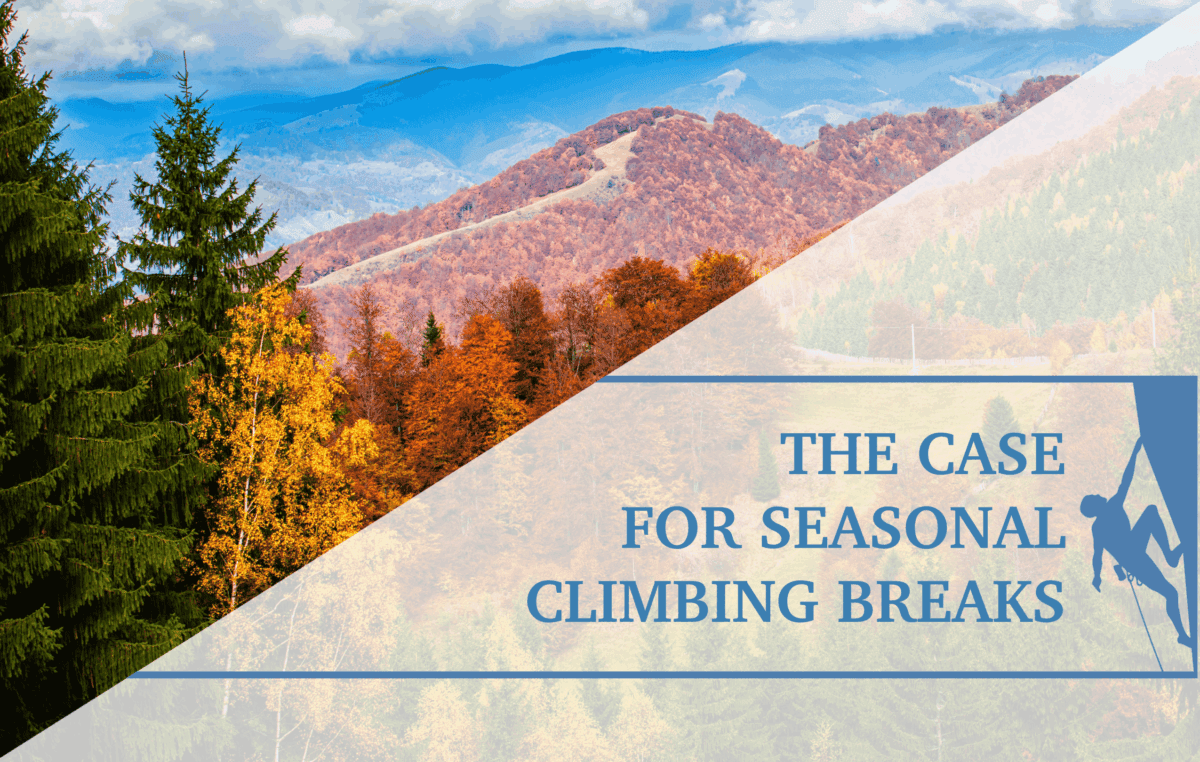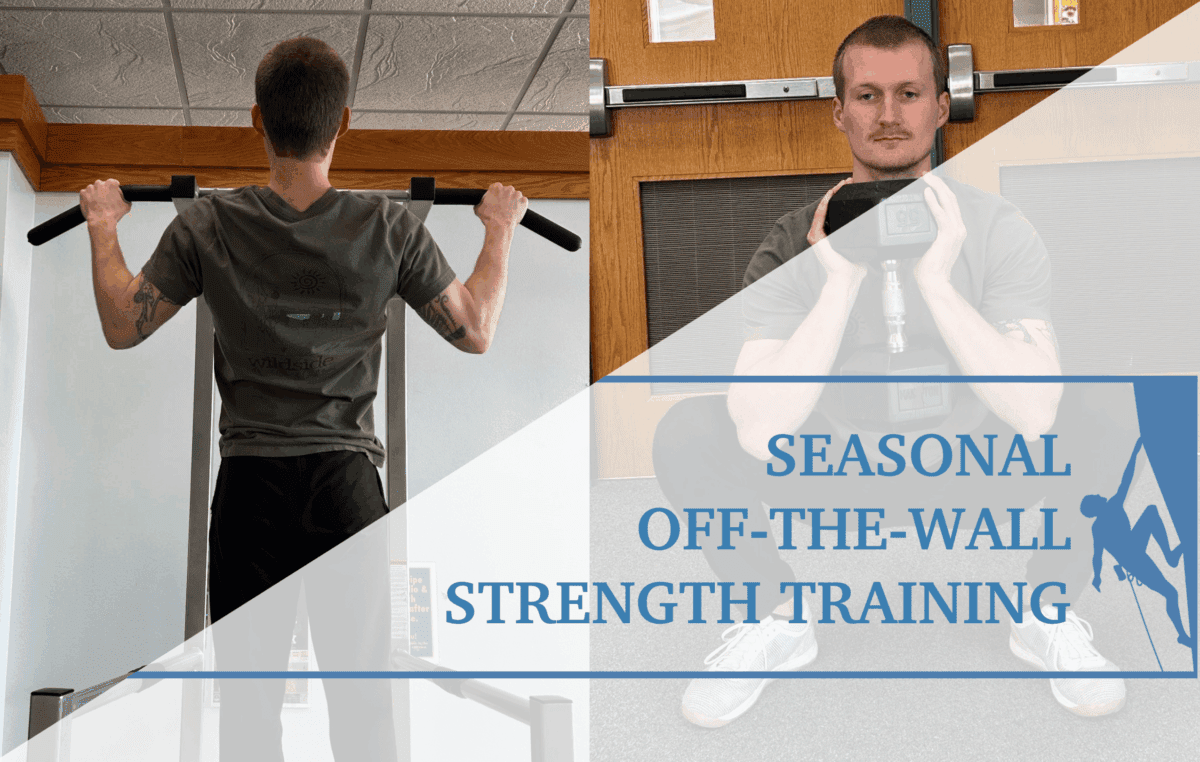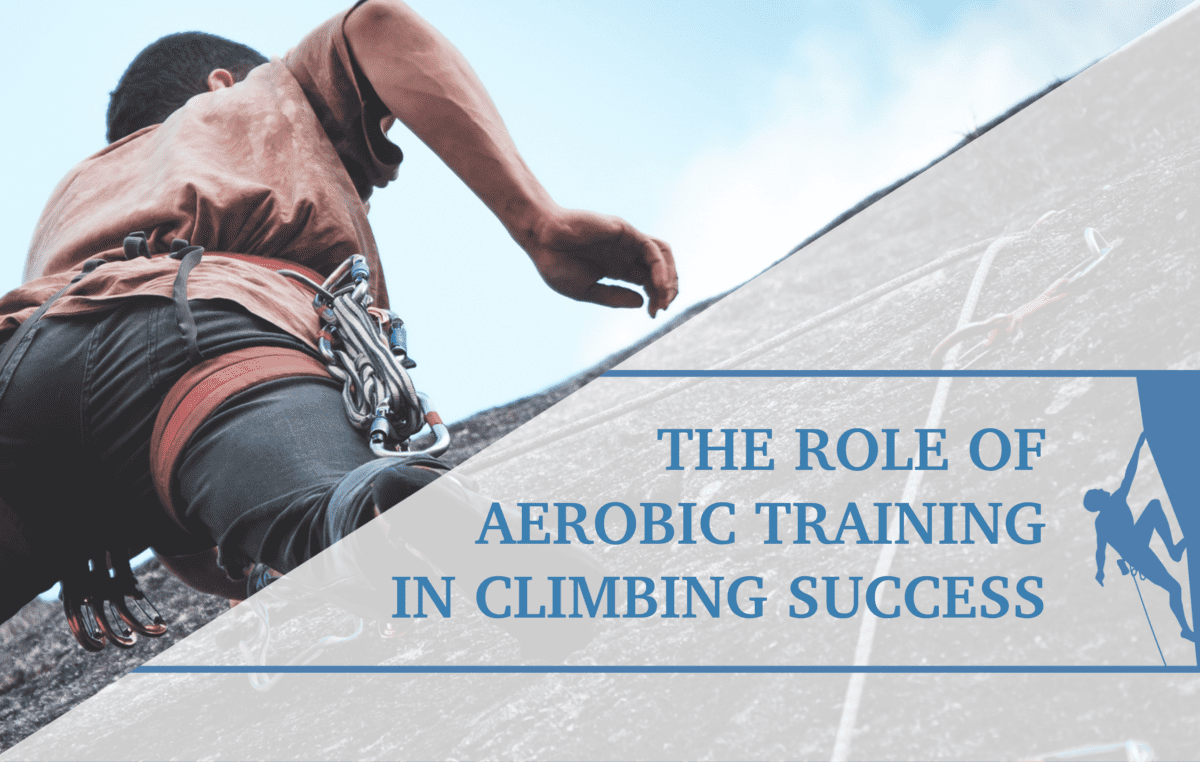Risk Assessment of Upper Extremity Overuse Injury in Climbing
Nothing strikes fear into the heart of the climber more than the prospect of something getting in the way of climbing. Unfortunately, in the pursuit of climbing more and climbing harder, climbers all too often face injury. Despite our best efforts, climbers are frequently injured in a variety of ways. Some are unavoidable, such as a sprained ankle from landing wrong on a boulder problem. However, a larger percentage of injuries are related to overuse, particularly to the muscles, tendons, and ligaments of the upper limb. Approximately 75% of climbers will face an overuse injury to their shoulders, arms, or fingers.7
These injuries can be particularly frustrating to deal with, as the healing process is often slow and nonlinear, making it difficult to determine the best course of action. While there are many protocols available for rehabilitation following various injuries to the upper limb, the best way to minimize time away from climbing due to injury is to avoid injury altogether. To do that, it is important to know how overuse happens in the first place. The goal of this article is to discuss the contributors to overuse and provide a framework for thinking about overuse injury risk.
Load and Load Tolerance
To understand overuse, it is important to understand load and load tolerance. Body tissues such as muscles, tendons, and bones are built to withstand and transmit force through the body to create movement. Every tissue has a limit to how much force, or load, it can tolerate when moving or creating tension. Nearing or exceeding that threshold leads to a small amount of damage to the tissue, which then slightly reduces the load that it can tolerate. However, the body has the incredible ability to respond to this damage and repair it, often supplementing it so it is stronger than before, in effect raising the load tolerance of the tissue. This is done as a means of preventing the damage from occurring again. This process is the foundation for strength training in sport, and climbing is no exception.
Unfortunately, the body has a limit to the rate that it can repair damage. If an individual exceeds the tolerance threshold for a given tissue, then does so again and again before the body has the chance to fully respond to the damage, the load tolerance of the tissue dips lower and lower until it reaches a point where it does not have the strength to complete what is otherwise a trivial motion. It is at this point that the climber determines they have an injury, as the injured area may begin to hurt with motions that do not require much strength. Additionally, the affected tissue may become swollen and stiffer as a protective mechanism, particularly in the mornings, and the climber may have decreased precision with movements of the affected limb. This process occurs gradually and is rarely attributed to a single incident, which is why the pain often seems to have come out of nowhere.1
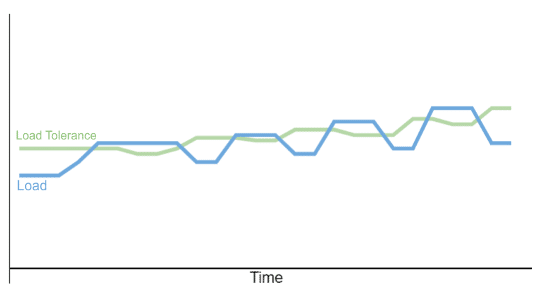
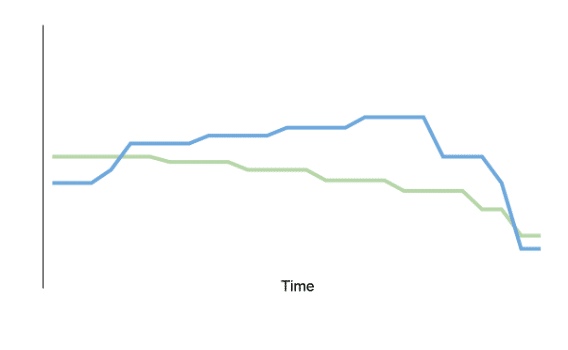
The figure depicts two hypothetical courses of increasing load when climbing. On the left is a successful loading progression in which the climber progressively increases load over the course of weeks and months, while allowing for periods of recovery in which load tolerance recovers and increases from the baseline as a compensation. On the right is a course in which there is no recovery period, so load tolerance continues to decline as the threshold is continually exceeded, resulting in injury over time.
Avoiding this situation may seem as simple as giving yourself a rest day every now and again, but both load placed on a tissue and load tolerance of a tissue are dependent on a myriad of factors. Finding the progression sweet spot in climbing requires that you balance and progress your load and load tolerance, so building an understanding of the factors that play into this paradigm is essential to avoid injury. If you load too little relative to your tolerance level, you will not see much progression (and you won’t be climbing as much as you could be), load too much, and your risk of overuse injury rises.
Predictors of Overuse Injury
While it is impossible to discuss every possible variable impacting load and load tolerance, understanding the significant risk factors will help bring awareness to modifiable behaviors and provide more control over the risks you take with your climbing training. We will divide risk factors into two categories: those that impact load, and those that impact load tolerance. Behaviors and patterns related to these factors increase or decrease risk of injury based on their ability to modify load and load tolerance.
Factors impacting Load:
- Training volume and type
- Biomechanical patterns
- Anatomy
Factors impacting Load Tolerance:
- Recovery
- Physiological considerations – sleep, fatigue, stress, anxiety
- Nutrition
Let’s expand on a few of these to understand how they relate to risk of overuse injury in climbing:
Training Volume and Recovery
The most important variables related to determining load and load tolerance. The frequency, duration, and intensity at which you participate in loading activities all modulate the load on your tissues. Climbing places a particularly high load on tissues of the upper extremity. Climbing frequently at max capacity is more likely to chronically exceed your load tolerance, increasing risk. It is important to vary the intensity of climbing sessions and incorporate periods of rest and recovery within your climbing schedule1. Common ways to do this include methods such as off days, cross training, mobility work, and periodic deloading weeks.
Training Type
Training type is a broad category that covers the methods a climber uses to progress in climbing. This includes how a climber utilizes the different disciplines of climbing, hangboard training, workout variety, strength training, cross training, and workout recovery methods. An effective training schedule often incorporates a variety of methods with a degree of specificity towards your goals. Variety in training not only improves overall performance, but also helps to distribute load across different parts of the body, so that the same body part is not always working at a high intensity. A lack of variety and a focus on higher intensity forms of training increases load1.
Anatomy
Anatomy is another factor that encompasses several variables. This includes. variables such as height, limb length, joint alignment, flexibility, and the strength of muscles and supportive structures relative to weight. Having limited mobility or a low strength-to-weight ratio both increase the relative load placed on the upper extremity1. Depicted on the right are just a few of the many muscles and tendons of the upper extremity, and each one needs sufficient strength and motion to tolerate the demands placed on them in climbing.


Physiological State & Nutrition
Sleep, stress, anxiety, age, nutrition, and a host of related variables all have a significant impact on the load tolerance of your tissues on a given day. Chronic sleep issues, prolonged periods of stress, and poor nutritional habits all have a detrimental effect on tissue health and motor performance.6
Issues with any of the above will lower load tolerance and increase risk when they are present over the course of weeks and months. In addition, normal age-related changes to the musculoskeletal system also slowly decrease tissue quality over time, leading to a lower load tolerance.1
Biomechanical Patterns
Movement patterns in climbing determine how load is distributed across the upper limb when on the wall. Patterns such as dead-hanging, full crimping, lock offs, chicken winging, and dynamic movement all focus higher load on specific muscles, tendons, ligaments, and bones of the upper extremity.2,5
In addition, poor utilization of the legs, whether due to inflexibility or insufficient activation, also increases load broadly across the upper extremity. It is important to note that most of these patterns are not inherently bad, and are at times necessary to complete a climb. However, constant and excessive utilization of high load movement increases risk, particularly for a newer climber who is unadapted to these movements. Several higher load patterns are demonstrated below, followed by the equivalent lower relative load pattern.
Dead Hanging
Dead hanging is characterized by passively hanging from shoulder structures, as opposed to engaging shoulder and upper back muscles to offload. Dead hanging is used to provide rest while climbing but increases load through ligaments of the shoulder.
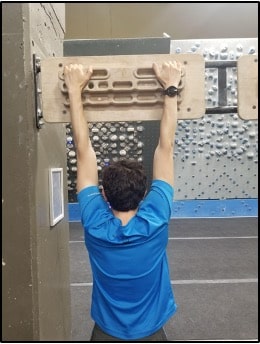
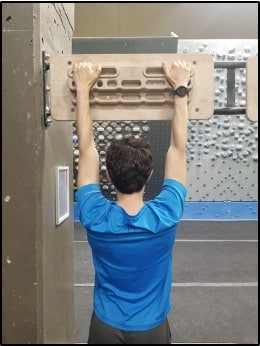
Locking Off
Locking off is when the climber pulls themselves up and holds their weight more with their elbow flexor muscles more so than shoulder and back muscles. This moves stress to the biceps and other elbow flexor muscles, which are more easily fatigued compared to the muscles of the back.
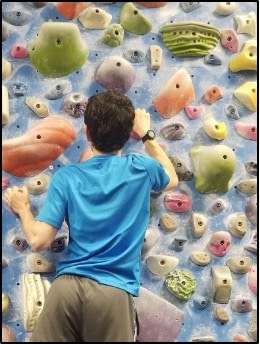
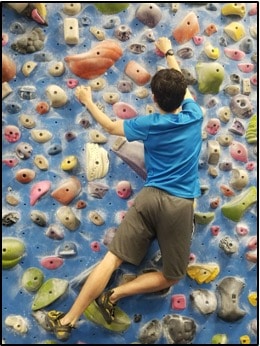
Chicken Winging
Chicken winging is characterized by wrist extension, shoulder internal rotation, and drawing the elbows upwards. It is often seen when the finger flexors become fatigued, as this pattern stretches the finger flexors, allowing more reliance on passive tension.This pattern places more stress on the wrist extensors and structures of the rotator cuff.
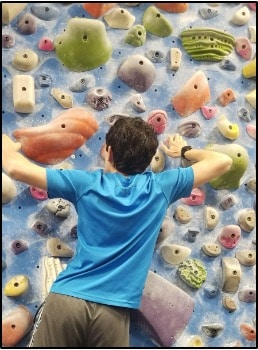
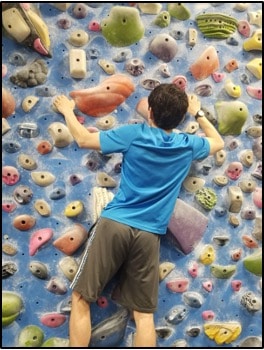
Climbing Grips
As you switch from an open hand to half crimp, and then to a full crimp grip, the load on the finger tendons increases and becomes more focused on specific joints, allowing for higher maximum tension on a hold.
Open Hand

Half Crimp
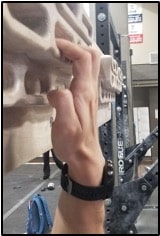
Full Crimp
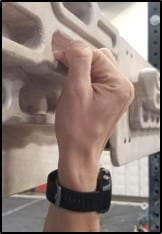
Risk Assessment
The basis of risk assessment is that the greater the exposure to risk factors, the greater the chances of an adverse outcome. In overuse injury, risk factors are variables that increase load and/or decrease load tolerance. The more factors that are present in a given climber, the higher the risk of an injury occurring. This is a simple enough concept, but with thousands of interacting variables at play to various extents in every climber, it is impossible to fully quantify individual risk. Training behaviors that work well for one person may quickly result in injury for another. Keeping that in mind, we can outline a framework that allows for a subjective assessment of overuse injury risk. As a disclaimer, this framework is solely used to guide thinking about how various behaviors and characteristics create risk. Each factor will be given a point value. To use this measure, assess your training behaviors and personal characteristics to determine which statements apply to you as outlined in the table below. Then, add your points and compare it to the scoring figure below.
| Training Volume (0-3) | Training Type (0-4) | Recovery (0-1) |
|---|---|---|
| +0 – Climbs 0-2 days per week. | +0 – 0-33% of climbing sessions are at a high intensity. | +0 – Climbing sessions include adequate warmup and recovery |
| +1 – Climbs 3-4 days per week | +1 – 33-67% of climbing sessions are at a high intensity. | +1 – Climbing sessions frequently do not include sufficient warmup or effective recovery methods between climbing days. |
| +3 – Climbs 5-7 days per week. | +3 – 67-100% of climbing sessions are at a high intensity. | +1 – Climbing sessions frequently do not include sufficient warmup or effective recovery methods between climbing days. |
| +3 – Climbs 5-7 days per week. | +1 – Training methods utilize little variety. | +1 – Climbing sessions frequently do not include sufficient warmup or effective recovery methods between climbing days. |
| Anatomy and Biomechanical Patterns (0-4) | Physiological Variables (0-4) |
|---|---|
| +0 – Has none of the concerns or patterns listed below | +0 – Has none of the concerns listed below. |
| +1 – Utilizes a higher load pattern such as chicken-winging, full crimping, lock-offs, dead-hanging, or frequently climbs with dynamic movement. | +1 – Frequently faces difficulty with sleep quality. |
| +2 – Utilizes 3 or more of the above patterns. | +1 – Frequently faces difficulty with management of stress, anxiety, depression, or related conditions. |
| +1 – Has a low strength-to-bodyweight ratio. | +1 – Has poor nutritional habits relative to the demands of their body.Column 2 Value 4 |
| +1 – Has mobility restrictions in one or more joints | +1 – Is >50 years old or has a condition that impacts their ability to tolerate exercise. |
Scoring
| Lower Risk 0-4 Points |
5-7 points | Medium Risk 8-10 Points |
11-13 points | Higher Risk 14-16 points |
|---|
A couple of points to remember when thinking about your risk score:
- A low risk score does not protect you from overuse injury, and a high risk score does not guarantee injury. They are merely indicators of relative likelihood. If you have a higher risk score, it may be helpful to assess your situation and identify methods that could reduce your score.
- The lowest possible risk score is not always a target to aim for. Progression in climbing ability generally requires higher training volume and intensity, so a small degree of risk is inevitable
When to See a Doctor of Physical Therapy
The best way to deal with injury is to understand how to avoid getting injured in the first place. Knowing your risk factors will certainly help in that pursuit, but sometimes things go wrong despite our best efforts.. If you are having trouble overcoming a nagging injury or have concerns about pain that is holding you back from climbing, it may be helpful to seek advice from a physical therapist. A physical therapist can perform a full evaluation and will work with you to determine a plan for achieving your goals, whether that is climbing that five star 5.14 or just getting to the climbing gym once a week without an old pain holding you back.
Author Bio

Greg Rinn is a second-year DPT student at the University of North Carolina at Chapel Hill, where he completed his undergraduate degree as well. Greg loves problems, so he was naturally drawn to both climbing and physical therapy. He has been climbing for 7 years, and when not seen climbing, he will likely be spotted running or biking nearby. His email is grinn124@gmail.com. Reach out if you have questions about climbing, physical therapy, or if you have a good hypothetical for him to muse over.
References
- Backe S, Ericson L, Janson S, Timpka T. Rock Climbing Injury Rates and Associated Risk Factors in a General Climbing Population. Scand J Med Sci Sports. 2009;19(6):850-856. doi:10.1111/j.1600-0838.2008.00851.x
- Donath, L., Roesner, K., Schöffl, V. and Gabriel, H.H.W. (2013), Upper-extremity Imbalance of Load Application. Scand J Med Sci Sports, 23: 406-414. https://doi.org/10.1111/j.1600-0838.2011.01399.x
- Jones, Gareth, Schöffl, Volker, Johnson, Mark I. Incidence, Diagnosis, and Management of Injury in Sport Climbing and Bouldering: A Critical Review. Current Sports Medicine Reports 17(11):p 396-401, November 2018. | doi: 10.1249/JSR.0000000000000534
- Jones G, Johnson MI. A critical review of the incidence and risk factors for finger injuries in rock climbing. Curr Sports Med Rep. 2016;15(6):400-409. doi:10.1249/JSR.0000000000000304
- Roseborrough A, Lebec M. Differences in Static Scapular Position Between Rock Climbers and A Non-Rock Climber Population. N Am J Sports Phys Ther. 2007;2(1):44-50. PMID: 21522202; PMCID: PMC2953287.
- Villavicencio P, Bravo C, Ibarz A, Solé S. Effects of Acute Psychological and Physiological Stress on Rock Climbers. J Clin Med. 2021 Oct 28;10(21):5013. doi: 10.3390/jcm10215013. PMID: 34768532; PMCID: PMC8584542.
- Wright DM, Royle TJ, Marshall T. Indoor Rock Climbing: Who Gets Injured?. Br J Sports Med. 2001;35(3):181-185. doi:10.1136/bjsm.35.3.181
- Disclaimer – The content here is designed for information & education purposes only and the content is not intended for medical advice.


